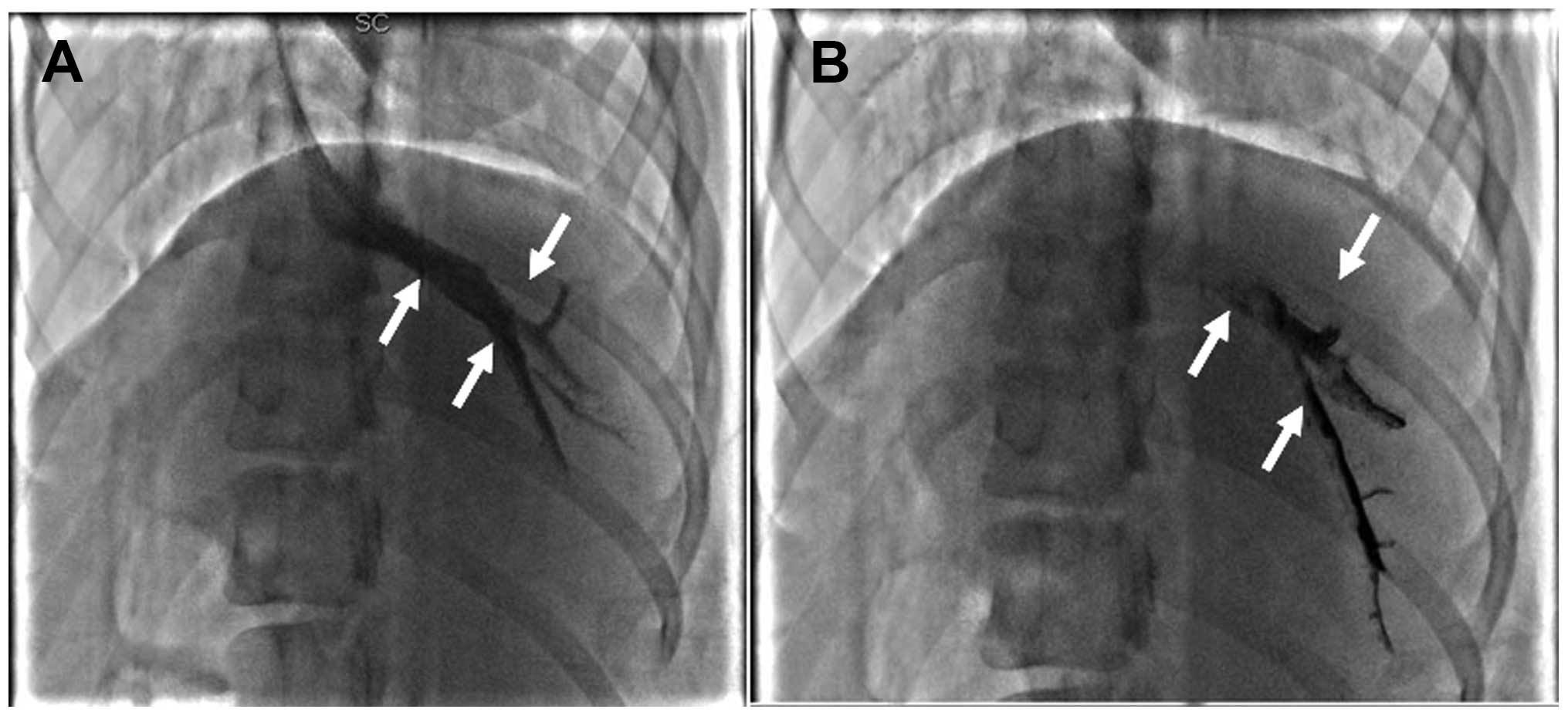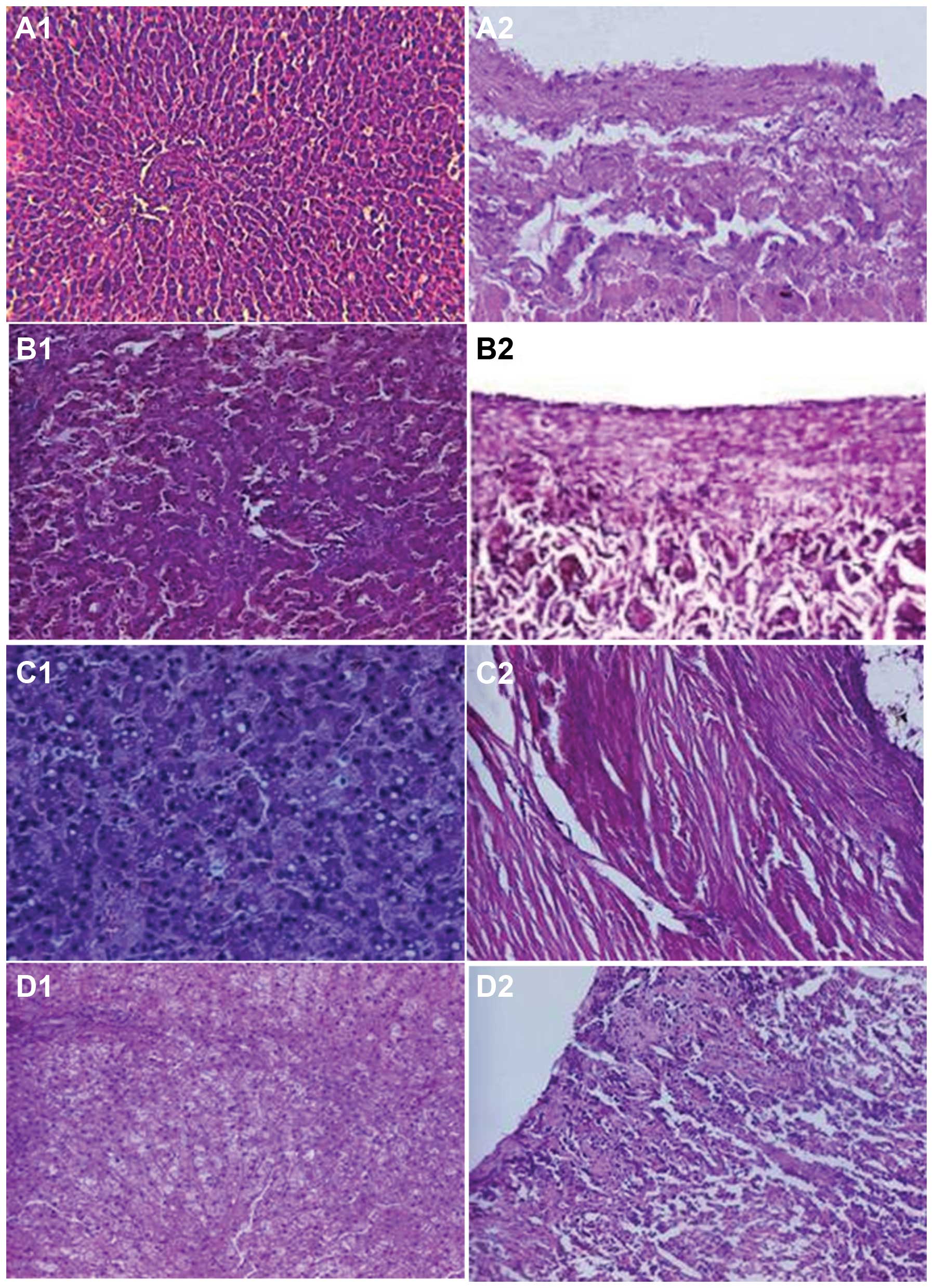|
1
|
Janssen HL, Garcia-Pagan JC, Elias E,
Mentha G, Hadengue A and Valla DC; European Group for the Study of
Vascular Disorders of the Liver. Budd-Chiari syndrome: a review by
an expert panel. J Hepatol. 38:364–371. 2003. View Article : Google Scholar
|
|
2
|
Valla DC: Primary Budd-Chiari syndrome. J
Hepatol. 50:195–203. 2009. View Article : Google Scholar : PubMed/NCBI
|
|
3
|
Horton JD, San Miguel FL, Membreno F, et
al: Budd-Chiari syndrome: illustrated review of current management.
Liver Int. 28:455–466. 2008. View Article : Google Scholar : PubMed/NCBI
|
|
4
|
Cura M, Haskal Z and Lopera J: Diagnostic
and interventional radiology for Budd-Chiari syndrome. Radio
Graphics. 29:669–681. 2009.PubMed/NCBI
|
|
5
|
Plessier A and Valla DC: Budd-Chiari
syndrome. Semin Liver Dis. 28:259–269. 2008. View Article : Google Scholar
|
|
6
|
Zeitoun G, Escolano S, Hadengue A, et al:
Outcome of Budd Chiari syndrome: a multivariate analysis of factors
related to survival including surgical portosystemic shunting.
Hepatology. 30:84–89. 1999. View Article : Google Scholar : PubMed/NCBI
|
|
7
|
Darwish Murad S, Valla DC, de Groen PC, et
al: Determinants of survival and the effect of portosystemic
shunting in patients with Budd-Chiari syndrome. Hepatology.
39:500–508. 2004.PubMed/NCBI
|
|
8
|
Langlet P, Escolano S, Valla D, et al:
Clinicopathological forms and prognostic index in Budd-Chiari
syndrome. J Hepatol. 39:496–501. 2003. View Article : Google Scholar : PubMed/NCBI
|
|
9
|
Garcia-Pagán JC, Heydtmann M, Raffa S, et
al: TIPS for Budd Chiari syndrome: long-term results and
prognostics factors in 124 patients. Gastroenterology. 135:808–815.
2008.PubMed/NCBI
|
|
10
|
Darwish Murad S, Dom VA, Ritman EL, et al:
Early changes of the portal tract on microcomputed tomography
images in a newly-developed rat model for Budd-Chiari syndrome. J
Gastroenterol Hepatol. 23:1561–1566. 2008.PubMed/NCBI
|
|
11
|
Akiyoshi H and Terada T: Centrilobular and
perisinusoidal fibrosis in experimental congestive liver in the
rat. J Hepatol. 30:433–439. 1999. View Article : Google Scholar : PubMed/NCBI
|
|
12
|
Pancholy SB, Sanghvi KA and Patel TM:
Radial artery access technique evaluation trial: randomized
comparison of Seldinger versus modified Seldinger technique for
arterial access for transradial catheterization. Catheter
Cardiovasc Interv. 80:288–291. 2012. View Article : Google Scholar
|
|
13
|
de Baere T, Deschamps F, Briggs P, et al:
Hepatic malignancies: percutaneous radiofrequency ablation during
percutaneous portal or hepatic vein occlusion. Radiology.
248:1056–1066. 2008.
|
|
14
|
Wang MQ, Duan F, Liu FY, Wang ZJ and Song
P: Treatment of symptomatic polycystic liver disease: transcatheter
super-selective hepatic arterial embolization using a mixture of
NBCA and iodized oil. Abdom Imaging. 38:465–473. 2013. View Article : Google Scholar
|
|
15
|
Yoo DH, Jae HJ, Kim HC, Chung JW and Park
JH: Transcatheter arterial embolization of intramuscular active
hemorrhage with N-butyl cyanoacrylate. Cardiovasc Intervent Radiol.
35:292–298. 2012. View Article : Google Scholar : PubMed/NCBI
|
|
16
|
Loewe C, Schindl M, Cejna M, Niederle B,
Lammer J and Thurnher S: Permanent transarterial embolization of
neuroendocrine metastases of the liver using cyanoacrylate and
lipiodol: assessment of mid- and long-term results. Am J
Roentgenol. 180:1379–1384. 2003. View Article : Google Scholar
|
|
17
|
Zwingenberger AL and Schwarz T: Dual-phase
CT angiography of the normal canine portal and hepatic vasculature.
Vet Radiol Ultrasound. 45:117–124. 2004. View Article : Google Scholar : PubMed/NCBI
|
|
18
|
Hoekstra J and Janssen HL: Vascular liver
disorders (I): diagnosis, treatment and prognosis of Budd-Chiari
syndrome. Neth J Med. 66:334–339. 2008.PubMed/NCBI
|
|
19
|
Mine T: Is hepatic vena cava disease an
endemic type of the Budd-Chiari syndrome? Hepatol Res. 37:170–171.
2007. View Article : Google Scholar : PubMed/NCBI
|
|
20
|
Tanaka M and Wanless IR: Pathology of the
liver in Budd-Chiari syndrome: portal vein thrombosis and the
histogenesis of veno-centric cirrhosis, veno-portal cirrhosis, and
large regenerative nodules. Hepatology. 27:488–496. 1998.
View Article : Google Scholar : PubMed/NCBI
|
|
21
|
Cazals-Hatem D, Vilgrain V, Genin P, et
al: Arterial and portal circulation and parenchymal changes in
Budd-Chiari syndrome: a study in 17 explanted livers. Hepatology.
37:510–519. 2003. View Article : Google Scholar : PubMed/NCBI
|
|
22
|
Shrestha SM: Liver cirrhosis and
hepatocellular carcinoma in hepatic vena cava disease, a liver
disease caused by obstruction of inferior vena cava. Hepatol Int.
3:392–402. 2009. View Article : Google Scholar : PubMed/NCBI
|
|
23
|
Hiraki T, Kanazawa S, Mimura H, et al:
Altered hepatic hemodynamics caused by temporary occlusion of the
right hepatic vein: evaluation with Doppler US in 14 patients.
Radiology. 220:357–364. 2001. View Article : Google Scholar : PubMed/NCBI
|
|
24
|
Küşük NO, Ozkan E, Aras G and Kir KM:
Visualization of collaterals in budd-chiari syndrome with Tc-99m
MDP bone scintigraphy and Tc-99m HMPAO-labeled leukocyte
scintigraphy. Clin Nucl Med. 28:236–237. 2003.PubMed/NCBI
|
|
25
|
Steingruber IE, Bodner G, Czermak B,
Hochleitner B and Jaschke W: Color-coded doppler sonographic
demonstration of intrahepatic venous collaterals in Budd-Chiari
syndrome. Ultraschall Med. 22:55–59. 2001.(In German).
|
|
26
|
Karaosmanoglu D, Karcaaltincaba M, Akata
D, Ozmen M and Akhan O: CT, MRI, and US findings of incidental
segmental distal hepatic vein occlusion: a new form of Budd-Chiari
syndrome? J Comput Assist Tomogr. 32:518–522. 2008. View Article : Google Scholar : PubMed/NCBI
|
|
27
|
Shih KL, Yen HH, Su WW, Soon MS, Hsia CH
and Lin YM: Fulminant Budd-Chiari syndrome caused by renal cell
carcinoma with hepatic vein invasion: report of a case. Eur J
Gastroenterol Hepatol. 21:222–224. 2009. View Article : Google Scholar : PubMed/NCBI
|
|
28
|
Amitrano L, Guardascione MA, Schiavone EM,
et al: Hepatic vein thrombosis leading to fulminant hepatic failure
in a case of acute non-promyelocytic myelogenous leukemia. Blood
Coagul Fibrinolysis. 17:59–61. 2006. View Article : Google Scholar : PubMed/NCBI
|













